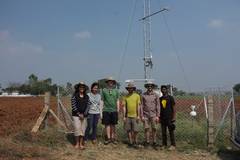INCOMPASS Project – Improving Weather and Climate Predictions of the Indian Monsoon
A team of scientists from the School of Earth and Environment are playing a leading role in a world-first field experiment in India, to improve weather and climate predictions of the monsoon. The group, led by Prof Doug Parker (CDT in Fluid Dynamics co-Director), forms part of the Anglo-Indian INCOMPASS project, which is making unprecedented observations of the land, ocean and atmospheric systems controlling the monsoon climate.
Research flights with the UK BAe146 research aircraft operated by the FAAM, have been conducted right across India, from the eastern and western reaches of the Indo-Gangetic plain in the north, to the Arabian Sea and Bay of Bengal, crossing the Deccan Plateau and Western Ghats in the south. A remarkable network of surface energy balance stations has also been established across the subcontinent, through partnership between the UK Centre for Ecology and Hydrology (CEH) and a number of Indian partners, including the Indian Institute of Science (IISc). An observational "supersite" has been set up at Kanpur in the north of India, including instruments installed by the NCAS Atmospheric Measurement Facility (AMF) at Leeds. INCOMPASS is jointly led by Andy Turner at the University of Reading and Prof GS Bhat at IISc.
 Image credit. The UK Facility for Airborne Atmospheric Measurements (FAAM)
Image credit. The UK Facility for Airborne Atmospheric Measurements (FAAM)
 Image Credit: Oliver Halliday. Leeds PhD student Oliver Halliday (2nd from the right) spent 3 weeks earlier in the year assisting scientists from CEH Wallingford and the Indian Institute of Science, Bangalore, in the installation of observational stations in the south of India. The installation is now part of a network of stations which span the Indian peninsula and provide data for the ongoing INCOMPASS field campaign. A UK/Indian collaboration, INCOMPASS aims to better understand convection interactions with the onset and evolution of the Indian monsoon
Image Credit: Oliver Halliday. Leeds PhD student Oliver Halliday (2nd from the right) spent 3 weeks earlier in the year assisting scientists from CEH Wallingford and the Indian Institute of Science, Bangalore, in the installation of observational stations in the south of India. The installation is now part of a network of stations which span the Indian peninsula and provide data for the ongoing INCOMPASS field campaign. A UK/Indian collaboration, INCOMPASS aims to better understand convection interactions with the onset and evolution of the Indian monsoon
